Sheep meat is not as popular as beef and pork, but it doesn’t necessarily mean it’s not worth raising sheep for meat. Generally speaking, sheep farming is more profitable than cattle farming.
Not to mention, lamb meat contains monounsaturated fats that can help reduce “bad” cholesterol levels. It is also rich in protein, vitamins, and minerals.
There is not one best sheep breed for meat production. It mainly depends on the consumers’ taste preference, the lambs’ growth rate, and the profit you will earn. But so far, Suffolk, Dorper, and Texel are among the very popular and favorite meat sheep breeds in the United States.
Sheep (Ovis aries) have been raised for wool and meat for centuries. Due to their small sizes and great behaviors, they are significantly easier to manage than cows and pigs.
There are more than 200 sheep breeds worldwide, but not all of them are considered meat breeds. Below are 12 sheep breeds to choose from if you want to raise them for meat.
12 Sheep Breeds for Meat
1. Suffolk Sheep
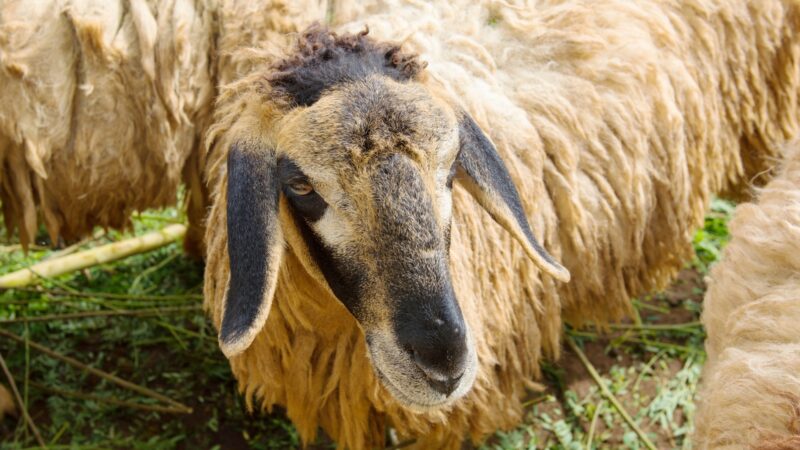
Place of Origin
The Suffolk is a domestic sheep that originated in Bury St Edmunds, a historic town in Suffolk, England, in the late 18th century. The original Suffolk sheep is the result of crossing Southdown rams and Norfolk Horned ewes and was called locally “Black faces” (or Southdown Norfolks). This sheep breed first arrived in the US in 1888.
Appearance
Suffolk sheep are characterized by their black faces and black legs. They have medium-length ears, long but small necks, broad shoulders, and muscular bodies.
The body and belly are well-covered with white, dense wool, while the legs below their knees are wool-free. Both the rams and ewes are hornless and described as polled sheep.
Height
The average height of Suffolk sheep is around 31-36 inches (81.3-91.4 cm) at the shoulder.
Weight
Mature rams weigh 250-350 lbs (113.4-158.7 kilos), and mature ewes weigh 180-250 lbs (81.6-113.4 kilos).
Lifespan
Suffolk sheep can live from 11 to 13 years.
Temperament
Suffolk sheep are extremely friendly, docile, and active. They are also smart, quick to learn, and easily adapt to various environments.
Rams are considered fearful and not aggressive, but they can attack anytime you disrespect them. Nevertheless, this British sheep breed is considered calmer than most other breeds.
Purpose
Suffolk sheep are primarily raised for their meat. Since their meat is of high quality, lambs are usually sold or butchered once they reach 90-120 lbs.
Nonetheless, their fleeces are of the medium wool type with a good spinning count. In some farms, rams and ewes are also used for crossbreeding due to their high fertility rate.
2. Dorper Sheep
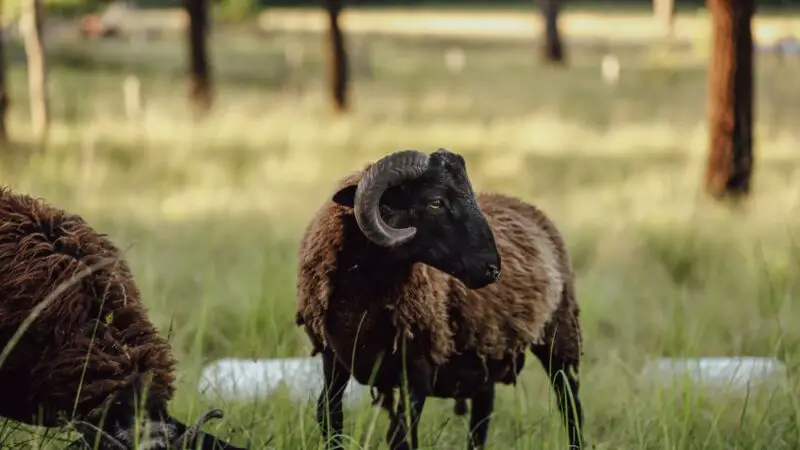
Place of Origin
The Dorper sheep originated in South Africa in the 1930s and was developed by the local Department of Agriculture. The breed was created by crossing Dorset Horn and Black-headed Persian, aiming to have a meat sheep suitable for different regions in the country. The name “Dorper” came from the first syllables of its parents’ names.
Appearance
The Dorper sheep has two varieties – the Black-headed Dorper and the White Dorper, which has a white head and white body. Both have relatively long barrel-shaped bodies, short and loose hair, short tails, and no horns. The head is quite triangular, the ears are long, and the eyes are widely spaced. Overall, this sheep breed looks stunning.
Height
The adult Dorper sheep has an average height of 24 inches (61 cm).
Weight
Mature Dorper rams have a live weight of 230-270 lbs (104.3-120.2 kilos), and mature ewes are about 180-210 lbs (49.9-79.8 kilos).
Lifespan
No records reveal the average lifespan of Dorper sheep. But then, ewes can give birth up to 7 years or more.
Temperament
Dorper sheep are known for being intelligent, quiet, and easy to work with. These South African sheep are a bit friendlier than most breeds.
Their curiosity helps them survive well enough in various kinds of habitats. They are also even-tempered and don’t easily get nervous. The white variety is slightly more docile than the black one, though.
Purpose
Dorper sheep were originally bred for meat production and still are. Yet, lamb meat is not the only why this breed is popular among breeders.
Interestingly, many Americans love the mutton meat (adult sheep meat) in this breed. And since Dorper sheep is considered a hair sheep, its wool has no economic value in the market.
Related: Dorset Horn Sheep | All You Need to Know!
3. Texel Sheep
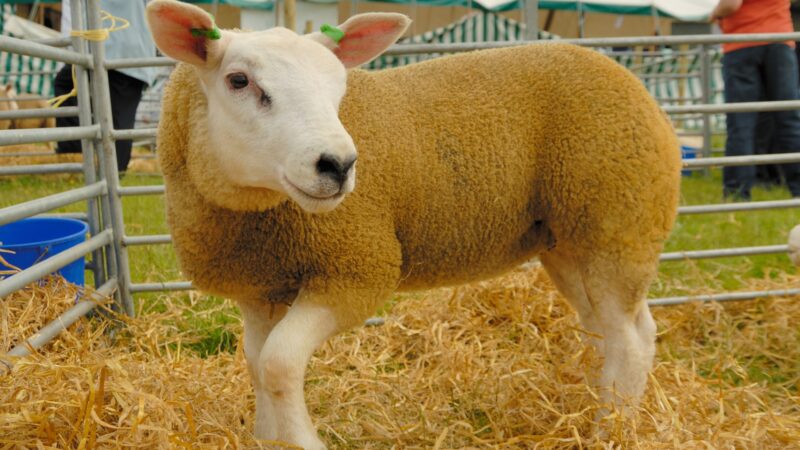
Place of Origin
The Texel sheep is named after its origin in Texel, a large, highly-populated municipality island in the Netherlands. Its exact origin is unknown, but theorists believe this breed is a product of crossing Leicester Longwool and Lincoln with the local breeds during the mid-1800s. The first Texel sheep in the US arrived only in 1985.
Appearance
Texel sheep are known for having broad, deep, and muscular bodies covered with white thin wool and are nearly horizontal. These remarkably solid sheep have short faces, black noses, short but widely placed ears, and black hooves.
Both sexes have no horns, and their head, face, and legs are wool-free. Their lambs are also heavily muscled.
Height
Adult Texel rams can grow up to 30 inches (76.25 cm) at the shoulder, while adult ewes can have a shoulder height of up to 26 inches (66.0 cm).
Weight
Adult Texel rams can weigh 190-240 lbs (86.2-108.9 kilos), and ewes weigh around 15-200 lbs (68.0-90.7 kilos).
Lifespan
Texel sheep have an average lifespan of 10-12 years.
Temperament
Texel sheep are known to have a gentle demeanor and excellent temperament. These white-faced sheep are docile, curious, and very easy to handle.
They don’t get nervous or excited easily compared to other sheep breeds. Note, however, that any individual sheep can be aggressive once you don’t treat it with respect and kindness.
Purpose
Because of their outstanding characteristics, Texel sheep are excellent meat producers. Their meat is very lean with less fat and is delicious.
Lambs grow very fast and reach their market weight very young. No wonder live Texel sheep and their meat are very expensive. Texel wool is also used for fine carpet yarns and knitting wool.
4. Hampshire Sheep
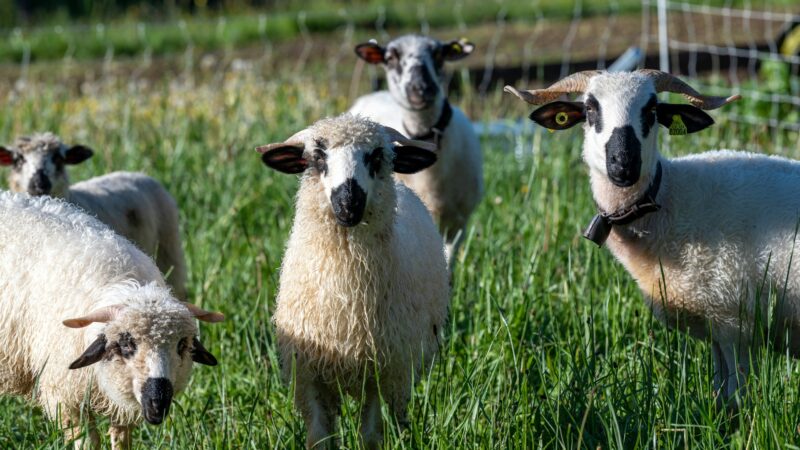
Place of Origin
As the name implies, the Hampshire sheep originated in Hampshire, a historic county in Southern England, sometime in 1829. At that time, a Hampshire farmer named John Twynam crossed Cotswold rams with his flock, and the result was outstanding. Since then, sheep farmers have improved the breed until it become superior.
Appearance
Also called the Hampshire Down, the Hampshire sheep has a deep, large body covered with white wool. They have a dark brown to black face and moderately long ears that are slightly dropped.
There is no wool from the eyes down and on their legs below the knee. Interestingly, their overall appearance looks like oxen but without horns.
Height
The average shoulder height of an adult Hampshire sheep is 25-50 inches (63.5-127 cm).
Weight
The Hampshire Down is one of the largest and heaviest sheep breeds. Mature Hampshire rams weigh at least 275 lbs (124.7 kilos), while adult ewes weigh around 200 lbs (90.7 kilos).
Lifespan
Hampshire sheep have a 9-20 years lifespan, but some of them can live up to 22 years.
Temperament
Despite having an intimidating size and appearance, Hampshire sheep are generally quiet, calm, and docile. Nonetheless, they are also curious and alert, and rams can charge small children and pets such as cats and dogs if provoked. Yet, these large sheep are known to keep their distance and avoid fights as much as possible.
Purpose
Due to their large size and heavy weight, Hampshire sheep are mainly raised for meat production. Ewes are heavy milkers, and their lambs grow very quickly.
Their meat has high quality and a delicate sweet flavor. Meanwhile, their white wool has medium length and is strong and fine enough for making socks, knitting yarn, and flannels.
5. Cheviot Sheep
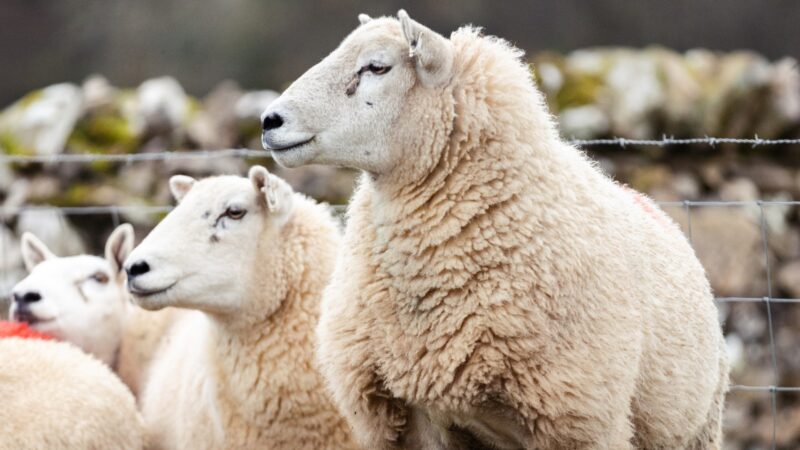
Place of Origin
The Cheviot sheep originated in the Cheviot Hills, a range of highlands that separates England and Scotland. The original breed was recognized as early as 1372 but was only brought to the US from Scotland in 1838. The modern American Cheviot breed is produced through selection rather than crossing the sheep to maintain its purity.
Appearance
Cheviot sheep have distinctive white faces, black noses, pricked ears, and feet. Their bodies are covered with white, long wool, while their well-defined head and legs are wool-free or with very fine white hair.
These sheep also have a lively carriage and black hooves. Although they are generally hornless, some rams may have short horns.
Height
The Cheviot sheep has an average shoulder height of 36 inches or 3 feet (91.4 cm).
Weight
Mature Cheviot rams weigh 160-200 lbs (72.6-90.7 kilos), while mature ewes can weigh between 120 and 160 lbs (54.4 and 72.6 kilos).
Lifespan
The lifespan of Cheviot sheep is around 8-12 years.
Temperament
Cheviot sheep are known for having a docile temperament. They are generally friendly, inquisitive, and easy to handle. As sociable animals, these relatively small sheep prefer living in a herd rather than in isolation.
This hardy breed is active and alert but requires low maintenance. Adult rams are low-tempered, and ewes tend to be great mothering skills.
Purpose
Cheviot sheep are a dual-purpose breed, which means they are raised for wool and meat production. Their meat is tasty and juicy, with enough fats and less waste, making it one of the most favorite meat cuts.
On the other hand, Cheviot wool has a distinctive soft, helical fiber and is durable enough, thus, offering good spinning qualities and resilience.
6. Dorset Sheep
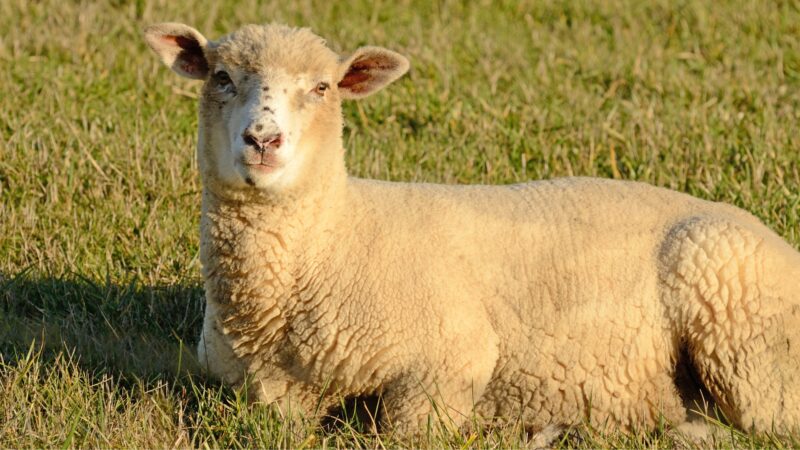
Place of Origin
As the name implies, the Dorset sheep originated in Dorset, a county in southwest England. There are two varieties – the Dorset Horn (documented in the 17th century) and the Polled Dorset (created in the US in the 1950s using purebred Dorset Horns). The Livestock Conservancy now lists Dorset Horns as an endangered species.
Appearance
The Dorset Horn and the Polled Dorset are identical except for the horn. Both Dorset varieties have long medium-sized bodies, wide clear faces, and pink noses.
Their bodies are covered with short-staple wool, while their face, ears, and legs are all wool-free. Note that the Polled Dorset is not the same species as the polled Dorsets in Australia.
Height
The Dorset sheep has a standard shoulder height of 34 inches (86.4 cm).
Weight
Dorset rams weigh 225-275 lbs (102.0-124.7 kilos), and ewes weigh 150-200 lbs (68.0-90.7 kilos).
Lifespan
Dorset sheep can live anywhere from 9 to 20 years.
Temperament
The horned and polled Dorset sheep are generally docile, friendly, and easy to handle. They can easily adapt to almost all kinds of environments.
Their extreme adaptability makes them a favorite of small, part-time purebred farmers and commercial producers. So far, the Polled Dorset is one of the most popular sheep breeds in the US.
Purpose
Dorset sheep have been kept primarily for meat production ever since and are known for their superior meat quality and superb taste. Unlike most seasonal breeders, this American sheep can be bred in the spring, and ewes can produce lambs twice a year. Mothers are prolific milkers, and giving multiple births is very common to them.
7. Barbados Blackbelly Sheep
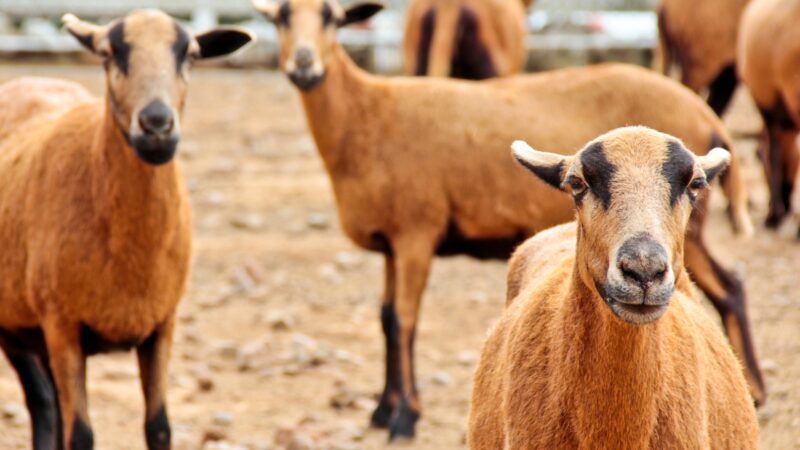
Place of Origin
As the name suggests, the Barbados Blackbelly sheep originated in Barbados island, a country in the Caribbean. Although there are no official records about their ancestors and parent breed, this sheep is believed to be the result of crossing African and Spanish sheep brought to the island by the Spaniards during the mid-1600s.
Appearance
The body of Barbados Blackbelly sheep has shades of reddish-brown, tan, or yellow, while their forehead, underparts, and the inside of their ears and legs are black.
Rams have thick wool, a Roman nose, and ears pointing forward from the side but do not droop. Both sexes are hornless and look like small deer or antelope from a distance.
Height
Adult male Barbados Blackbelly sheep can reach a height of around 25-35 inches (63.5-88.9 cm) at the shoulder. Females are about 20-30 inches (50.8-76.2 cm) tall.
Weight
Adult male Barbados Blackbelly sheep weigh 100-130 lbs (45.4-60.0 kilos), while adult females weigh 85-100 lbs (38.5-45.4 kilos).
Lifespan
Barbados Blackbelly sheep can live up to 13 years in captivity but are likely to live shorter in the wild.
Temperament
Barbados Blackbelly sheep are generally docile and friendly and are known for their good disposition. They are very sociable animals but can also be kept as solo pets.
But as a small sheep breed, ewes tend to be reactive to strange cats and dogs and may try to run away. On the contrary, mature rams may attack small dogs even without provocation.
Purpose
Barbados Blackbelly sheep are mainly raised for meat production. Despite having small carcasses, their meat is lean and tastes excellent.
It is also milder and contains less fat than most other sheep meat. Barbados sheep meat is not ideal for commercial production, though. Yet, ewes are known for giving birth to twins or triplets.
8. Katahdin Sheep
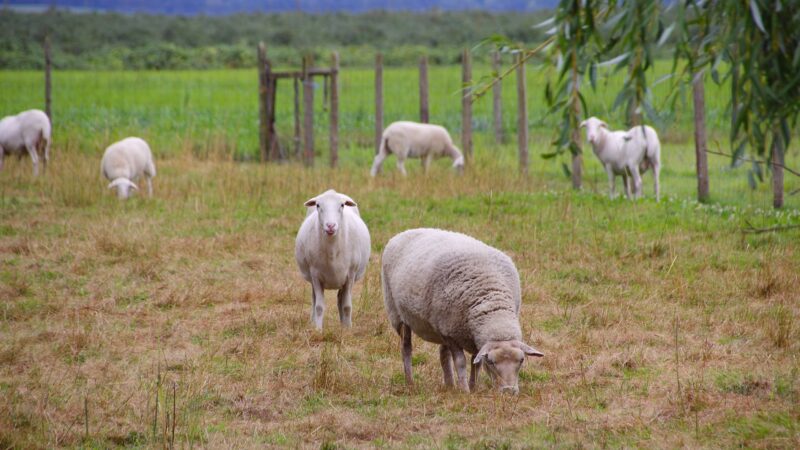
Place of Origin
Katahdin sheep originated in Maine, United States, between 1956 and 1957. This American sheep breed was developed by a local breeder and innovator named Michael Piel. He named it after Mount Katahdin, the highest peak in the state. At that time, he used sheep breeds, such as Hampshire, St. Croix, Southdown, Suffolk, and Tunis.
Appearance
Katahdin sheep look like goats since they wear short, fine hair coats. Most are white, but some may show beige or light gray spots or are pure brown.
Unlike most sheep breeds, they don’t produce wool and don’t require shearing and crutching. These hornless sheep have sturdy bodies, a distinctive rose nose, and medium, upright ears.
Height
There are no official records about the height of the Katahdin sheep. But judging from their medium to large size, they are reasonably taller than most sheep breeds.
Weight
Mature Katahdin rams weigh 180-250 lbs (81.6-113.4 kilos), and mature ewes usually weigh 120-160 lbs (54.4-72.6 kilos).
Lifespan
Like most domestic sheep breeds, Katahdin can live for 10-12 years.
Temperament
Katahdin sheep are docile, calm, and highly adaptable to warm environments. These goat-like sheep are easy to handle and are not prone to nervousness or aggression.
And because Katahdin sheep also require less maintenance, this makes them a good choice for those with little experience with raising livestock and beginners.
Purpose
Katahdin sheep wool has no economic value, so this animal is mainly bred for meat production. Their meat is tender, juicy, and lean.
They are also the first sheep breed in the United States to pass the standards of carcass quality in the sheep industry. And since labor and maintenance cost is fairly low, meat prices are also considerably low.
9. Tunis Sheep
Place of Origin
Tunis originated in Tunisia in Africa, hence the name. It was first introduced to the United States in 1799 when the Bey of Tunis (Tunisia ruler) gave a pair of these mammals to then-US President George Washington as a gift. Since then, the breed has become popular in the country, and breeders developed an American version of the Tunis.
Appearance
The Tunis sheep have creamy-colored, dense fleeces (wool) on their bodies and red or red-brown faces and legs. They have loose ears, which makes them look alert and very smart.
Rams (male sheep) are usually longer than ewes (female sheep). Both sexes are hornless and have no wool on their head, ears, and legs. Lambs have red double coats.
Height
Adult Tunis rams typically stand 32-36 inches (81.2-91.4 cm) tall at the shoulder, while ewes are 28-32 inches tall or about 2-4 inches shorter.
Weight
Adult Tunis rams weigh between 175-225 lbs (79.4-102.1 kilos), while ewes can weigh around 25-50 lbs lighter.
Lifespan
With proper care and nutrition, the lifespan of a Tunis sheep can range from 8 to 12 years.
Temperament
Tunis sheep are known to be very docile, gentle, and intelligent. They are generally easy to handle and friendly, even for novice sheep owners.
With proper handling, this sheep breed is friendly and trusts humans easily. They also adapt to various environments, including small homesteads and large commercial operations.
Purpose
Tunis sheep used to be a dual-purpose breed but are now mainly raised for meat production. Their meat is famous for being tender, tasty, and high-quality.
On the other hand, Tunis wool is soft, dense, and medium-grade. It has a staple length of 3-5 inches and weighs around 7-12 lbs, and is often used in clothing and other textiles.
10. Black Welsh Mountain Sheep
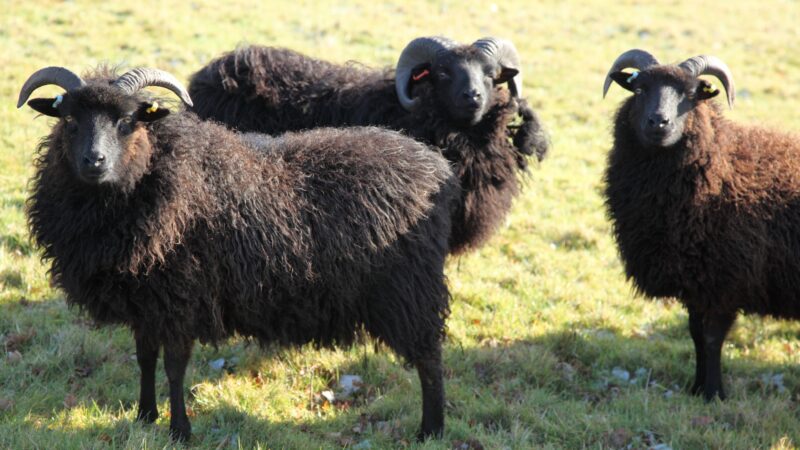
Place of Origin
The Black Welsh Mountain sheep originate in Wales, in the United Kingdom, hence the name. It was developed in the mid-19th century using the Welsh Mountain sheep, which is all-white.
Tom Wyman of New York first imported this black sheep breed to the United States in 1973. The Livestock Conservancy currently lists it as “Threatened.”
Appearance
Aside from the color, Black Welsh Mountain sheep are identical to their original white version. These small to medium-sized sheep also have no wool on their face and legs below their knees.
They also have thick and moderately long wool on their bodies with long tails. Rams have huge curved horns, while ewes are mostly without horns.
Height
The Black Welsh Mountain sheep have an average shoulder height of 20-30 inches (50.8-76.2 cm).
Weight
Black Welsh Mountain rams weigh between 165-198 lbs (74.8-89.8 kilos), and ewes weigh around 99-121 lbs (45.0-54.8 kilos).
Lifespan
Black Welsh Mountain sheep can live for 10- 12 years.
Temperament
Black Welsh Mountain sheep are calm, placid, and very independent. They are also curious, cooperative, and a joy to be with. Interestingly, this sheep breed is not only popular among breeders in different parts of the world. A Boston-based rock band named State Radio released a song in 2012 entitled “Black Welsh Mountain.”
Purpose
Black Welsh Mountain sheep are a dual-purpose breed – for meat and wool production. Mutton meat has a rich texture, a distinct flavor, and a favorable meat-to-bone ratio.
On the other hand, thick black wool is very useful in manufacturing tweeds and other clothing. This durable wool can also be combined with other wool.
11. Charollais Sheep
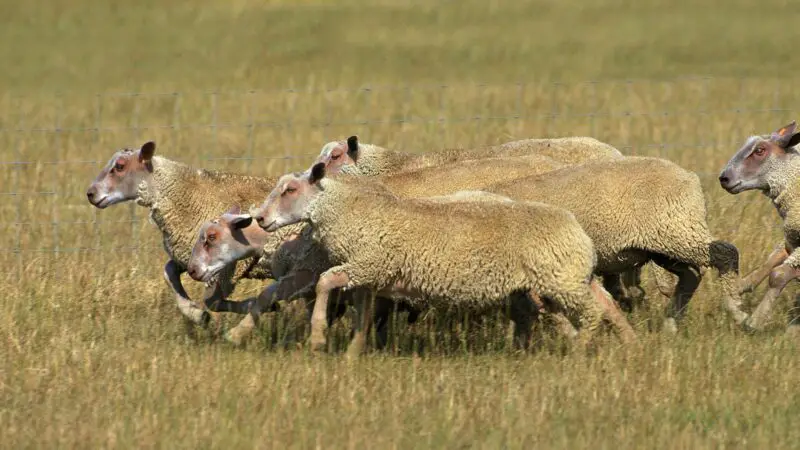
Place of Origin
The Charollais sheep originated in Charolles and Saone-et-Loire in east-central France in the early 1800s. This French sheep is the result of crossing Leicester Longwool sheep and some local breeds.
It was introduced in the UK in 1976 and in Ireland and Canada in 1990 and 1994, respectively. There are no records of Charollais sheep in the US, though.
Appearance
The Charollais sheep is a medium to large sheep breed with pale white fine wool all over its body. It has a well-muscled body, a long wedge-shaped back, and a pink or grayish head that is majority without wool.
Their legs are brown, short but balanced, and also wool-free. More importantly, rams and ewes are polled (without horns).
Height
Charollais sheep have an average height of 24 inches (61 cm).
Weight
A mature Charollais ram weighs around 220-330 lbs (99.8-149.7 kilos), while a mature ewe weighs 176-220 lbs (79.8-99.8 kilos).
Lifespan
Charollais sheep can live for 10 years or more.
Temperament
Charollais sheep are famous for being docile, quiet, and easy to handle. Rams are hardworking and relatively easy, with ewes having an extended breeding season.
They are also bred with ewes of other sheep breeds and are considered among the UK’s most used terminal sire breeds. Charollais ewes are extremely caring mothers.
Purpose
Charollais sheep are known for having fine bones and producing high-quality meat. Their carcasses produce an extra rib, making them one of the world’s highest meat-to-bone ratio sheep breeds.
Compared to other sheep breeds, they also have higher intramuscular fat and lower subcutaneous fat. Not to mention, their meat tastes great.
12. Icelandic Sheep
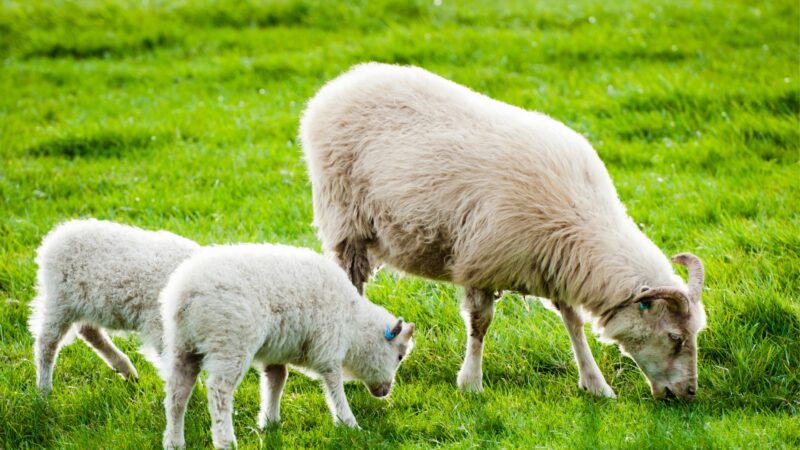
Place of Origin
The origin of Icelandic sheep is not well documented. However, it is believed to have been introduced in Iceland by the Vikings between the 9th and 10th centuries.
Hence, it has been on Earth for more than 11,000 years and is considered the oldest pure sheep breed. Icelandic sheep is the largest among the Northern European Short-tailed sheep.
Appearance
Icelandic sheep are known for having double-coated wool to protect their bodies against the cold in the country. They are mostly white, but some strains may be black, brown, or gray.
Only their faces and legs have no wool. Adults of both sexes have short tails and large spiral horns, except for the Kleifa strain, which is naturally hornless.
Height
There are official records about the height of Icelandic sheep. But their gigantic size makes them the tallest sheep in the Northern European Short-tailed group.
Weight
Icelandic rams can weigh between 180 and 220 lbs (81.6 and 99.8 kilos), while adult ewes weigh around 130-160 lbs (59.0-72.6 kilos).
Lifespan
Icelandic sheep are very cold-hardy and can generally live for up to 13 years. However, most lambs are slaughtered once they are 4-5 months old.
Temperament
Unlike other sheep breeds, Icelandic sheep have a mixed temperament. They are generally friendly but not docile.
These horned sheep are curious, active, and quite aggressive to others (especially rams) or when they are agitated. Icelandic sheep can easily get frightened and nervous. They don’t jump a lot but can run very fast.
Purpose
Icelandic sheep are predominantly used for meat production in Iceland. Icelandic lamb meat is very tender and is used in several traditional dishes in the country.
Meanwhile, their wool is famous worldwide for being unique and is one of the main exports in the country. Locally, Icelandic wool is used for making the famous lopapeysa sweaters.
Related Questions
What is the Fastest-Growing Sheep Breed?
There are no official records stating which sheep is the fastest-growing sheep breed. Nonetheless, Suffolk, Dorper, and Texel are great contenders. A 3.5-month-old Suffolk weighs around 67 lbs, while a 4-month-old Dorper lamb weighs 80-90 lbs. Meanwhile, Texel lambs have an average growth rate of 250 grams daily.
What is the Most Expensive Sheep Breed?
Merino sheep are notably very expensive, as a ram named Collinsville Emperor 395 was sold in Australia in 2022 for AU$115,000 (around $165,000). However, a Texel sheep named Double Diamond is currently considered the world’s most expensive sheep. In 2020, the ram was sold for a whopping 350,000 guineas, approximately $490,000.
Is It Worth Raising Sheep for Meat?
It is worth raising sheep for meat. Unlike other farm mammals, sheep don’t require a lot of space. Ideally, you only need one acre of land to support 3-4 ewes and their lambs.
Sheep are also not picky eaters and eat grass and weeds even in poor soil. But more importantly, they are generally docile, intelligent, and easy to train.
